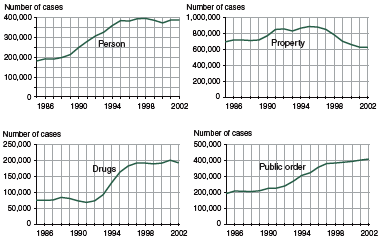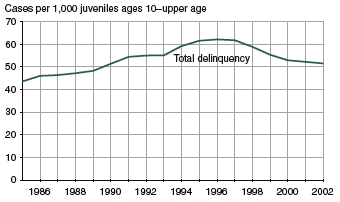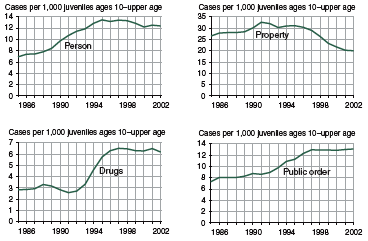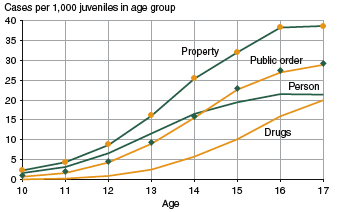Chapter 2
National Estimates of Delinquency Cases
Delinquency offenses are acts committed by juveniles that, if committed by an adult, could result in criminal prosecution. This chapter documents the volume of delinquency cases referred to juvenile court and examines the characteristics of these cases, including types of offenses charged, demographic characteristics of the juveniles involved (age, gender, and race), and sources of referral.
Analysis of case rates permits comparisons of juvenile court activity over time while controlling for differences in the size and demographic characteristics of the juvenile population. Rates are calculated as the number of cases for every 1,000 juveniles in the populationthose age 10 or older who were under the jurisdiction of a juvenile court.1
The chapter focuses on cases disposed in 2002 and examines trends since 1985.
Counts and Trends
-
In 2002, courts with juvenile jurisdiction handled an estimated 1,615,400 delinquency cases.
- In 1960, approximately 1,100 delinquency cases were processed daily. In 2002, juvenile courts handled about 4,400 delinquency cases per day.
- The number of delinquency cases processed by juvenile courts increased 41% between 1985 and 2002.
- Between its peak year 1997 and 2002, the delinquency caseload declined 11%.
- The number of drug law violation cases increased 159% between 1985 and 2002, while both person and public order offense cases increased 113%. In comparison, property offense cases decreased 10% during this period.
- Public order offense cases accounted for nearly half (46%) of the growth in the delinquency caseload between 1985 and 2002. Person offense cases made up another 44% of the increased number of delinquency cases processed during this time period.
Offense profile of delinquency cases
| Most serious offense |
1985 |
2002 |
|
| Person |
16%
|
24%
|
| Property |
61
|
39 |
| Drugs |
7 |
12
|
| Public order |
17
|
25 |
| Total |
100% |
100%
|
Note: Detail may not total 100% because of rounding. |
- Compared with 1985, a much smaller proportion of the court's delinquency caseload in 2002 was property offenses.
Between 1960 and 2002, juvenile court delinquency caseloads increased nearly 300%; in the last 5 years, caseloads have declined 8%

Between 1985 and 2002, delinquency caseloads involving person, drug, and public order offenses more than doubled; in contrast, the property offense caseload decreased 10%

In recent years, the number of cases handled by juvenile courts has decreased for most offense categories
Most serious offense |
Number of cases
|
Percent change
|
2001 |
2002 |
1993
2002 |
1998
2002 |
2001
2002 |
|
Total delinquency |
1,620,800 |
1,615,400 |
6% |
8% |
0% |
Total person |
388,000 |
387,500 |
19 |
2 |
0 |
Criminal homicide |
1,500 |
1,700 |
40 |
19 |
11 |
Forcible rape |
5,000 |
4,700 |
29 |
9 |
7 |
Robbery |
22,000 |
21,500 |
38 |
28 |
2 |
Aggravated assault |
49,400 |
47,400 |
34 |
21 |
4 |
Simple assault |
270,000 |
270,700 |
52 |
4 |
0 |
Other violent sex offenses |
13,800 |
16,400 |
39 |
30 |
19 |
Other person offenses |
26,200 |
25,200 |
22 |
1 |
4 |
Total property |
628,100 |
624,900 |
25 |
20 |
1 |
Burglary |
101,000 |
100,000 |
33 |
23 |
1 |
Larcenytheft |
286,500 |
284,400 |
24 |
20 |
1 |
Motor vehicle theft |
37,500 |
38,500 |
39 |
20 |
3 |
Arson |
8,300 |
8,100 |
5 |
4 |
3 |
Vandalism |
94,900 |
94,800 |
20 |
16 |
0 |
Trespassing |
50,600 |
50,800 |
20 |
20 |
0 |
Stolen property offenses |
23,600 |
22,100 |
29 |
31 |
6 |
Other property offenses |
25,900 |
26,200 |
9 |
14 |
1 |
Drug law violations |
201,500 |
193,200 |
110 |
1 |
4 |
Public order offenses |
403,200 |
409,800 |
52 |
7 |
2 |
Obstruction of justice |
187,100 |
182,600 |
93 |
7 |
2 |
Disorderly conduct |
97,600 |
108,500 |
56 |
25 |
11 |
Weapons offenses |
36,500 |
35,900 |
24 |
17 |
1 |
Liquor law violations |
26,500 |
28,200 |
92 |
20 |
6 |
Nonviolent sex offenses |
15,300 |
15,500 |
45 |
25 |
1 |
Other public order offenses |
40,200 |
39,000 |
19 |
19 |
3 |
Violent Crime Index* |
78,000 |
75,300 |
35 |
23 |
3 |
Property Crime Index** |
433,200 |
431,000 |
27 |
21 |
1 |
* Includes criminal homicide, forcible rape, robbery, and aggravated assault.
** Includes burglary, larceny-theft, motor vehicle theft, and arson.
Note: Detail may not add to totals because of rounding.
Percent change calculations are based on unrounded numbers. |
- Compared with 1993, juvenile courts handled 110% more drug law violation cases in 2002, 93% more obstruction of justice cases, 92% more liquor law violation cases, 56% more disorderly conduct cases, and 52% more simple assault cases.
- Between 1998 and 2002, caseloads dropped in several offense categories, including stolen property offenses (31%), robbery (28%), burglary (23%), aggravated assault (21%), trespassing (20%), larceny-theft (20%), motor vehicle theft (20%), and criminal homicide (19%).
- Trends in juvenile court cases paralleled trends in arrests of persons younger than 18. The number of juvenile court cases involving offenses included in the FBI's Violent Crime Index2 (criminal homicide, forcible rape, robbery, and aggravated assault) declined 23% between 1998 and 2002. The FBI reported that the number of arrests involving persons younger than age 18 charged with Violent Crime Index offenses decreased 17% during this same period.
- Between 1998 and 2002, the volume of juvenile court cases involving Property Crime Index offenses (burglary, larceny-theft, motor vehicle theft, and arson) declined 21%, and the FBI reported arrests of persons under age 18 for Property Crime Index offenses decreased 23%.
Case Rates
-
More than 31 million youth were under juvenile court jurisdiction in2002. Of these youth, 8 in 10 (80%) were between the ages of 10 and 15,12% were age 16, and 8% were age 17. The small proportion of 16- and17-year-olds among the juvenile court population is related to the upper age of juvenile court jurisdiction, which varies by state. In 2002, youth age 16 in 3 states were under the original jurisdiction of the criminal court, as were youth age 17 in an additional 10 states.
In 2002, juvenile courts processed 51.6 delinquency cases for every 1,000 juveniles in the populationthose age 10 or older who were under the jurisdiction of a juvenile court.
-
The total delinquency case rate increased 43% between 1985 and 1996 and then declined 17% to the 2002 level.3
-
Between 1985 and 2002, case rates increased in three of the four general offense categories: drug law violations by 117%, and person offenses and public order offenses each by 79%.
-
In contrast to other offensecategories, case rates for propertyoffenses declined 25% between 1985and 2002.
Delinquency case rates rose from 43.6 to 62.2 per 1,000 juveniles between 1985 and 1996 and then steadily declined to 51.6 in 2002

Between 1991 and 2002, case rates for drug offenses increased 138% (from 2.6 to 6.2 per 1,000 juveniles)

Age at Referral
In 2002, juveniles younger than age 16 accounted for more than half of all delinquency cases, including nearly two-thirds of person offense cases

Between 1998 and 2002, delinquency case rates declined for all age groups
|
|
Case rate
|
|
Year
|
Age 10 |
Age 11 |
Age 12 |
Age 13 |
Age 14 |
Age 15 |
Age 16 |
Age 17 |
|
1985 |
5.9 |
9.9 |
18.2 |
33.2 |
50.3 |
66.2 |
79.4 |
80.7 |
1986 |
5.7 |
9.3 |
17.8 |
33.8 |
52.9 |
70.0 |
85.5 |
86.0 |
1987 |
5.7 |
9.8 |
18.3 |
34.4 |
54.7 |
71.4 |
85.0 |
86.3 |
1988 |
6.0 |
9.7 |
19.2 |
35.5 |
57.2 |
73.7 |
87.8 |
88.7 |
1989 |
6.0 |
10.7 |
20.2 |
38.7 |
58.9 |
77.9 |
92.1 |
88.9 |
1990 |
6.2 |
11.0 |
21.7 |
41.1 |
65.2 |
83.5 |
100.5 |
97.2 |
1991 |
6.5 |
11.7 |
23.2 |
45.2 |
68.6 |
90.9 |
104.7 |
104.1 |
1992 |
6.1 |
11.6 |
23.1 |
45.4 |
71.9 |
90.2 |
107.3 |
104.0 |
1993 |
5.6 |
10.6 |
22.5 |
44.6 |
71.3 |
93.6 |
106.9 |
107.5 |
1994 |
6.0 |
11.3 |
23.7 |
48.3 |
75.2 |
98.8 |
117.0 |
111.7 |
1995 |
6.0 |
11.7 |
24.9 |
48.4 |
78.0 |
100.7 |
120.6 |
117.5 |
1996 |
5.8 |
11.3 |
24.4 |
47.9 |
75.7 |
103.3 |
121.7 |
123.8 |
1997 |
5.5 |
11.3 |
24.5 |
47.5 |
75.2 |
99.9 |
123.8 |
122.5 |
1998 |
5.4 |
10.7 |
23.1 |
44.6 |
71.1 |
95.4 |
115.4 |
121.6 |
1999 |
5.1 |
10.3 |
22.3 |
42.7 |
66.1 |
90.5 |
110.2 |
111.9 |
2000 |
5.1 |
10.1 |
21.4 |
40.7 |
65.1 |
85.2 |
103.7 |
110.8 |
2001 |
5.0 |
9.8 |
21.2 |
40.7 |
63.4 |
85.5 |
103.8 |
109.0 |
2002 |
4.6 |
9.3 |
20.4 |
39.2 |
63.2 |
84.3 |
102.9 |
109.1 |
Case rate = Cases per 1,000 juveniles in age group.
|
-
In 2002, 58% of all delinquency cases processed by the juvenile courts involved youth age 15 or younger at the time of referral.
-
The proportion of cases involving juveniles age 15 or younger varied by offense: younger juveniles accounted for a smaller proportion of drug and public order cases than of person and property offense cases.
-
With the exception of 10- and 11year-olds, age-specific case rates in 2002 were above the rates in 1985; however, in the 5 years between 1998 and 2002, age-specific case rates dropped 12% on average.
Offense profiles of delinquency cases by age group:
| Most serious offense |
Age 15 or younger |
Age 16 or older |
|
|
2000
|
|
|
Person |
27% |
20% |
Property |
40 |
36 |
Drugs |
9 |
17 |
Public order |
24 |
27 |
Total |
100% |
100% |
1985 |
Person |
16% |
15% |
Property |
64 |
56 |
Drugs |
5 |
9 |
Public order |
15 |
20 |
Total |
100% |
100% |
Note:
Detail may not total 100% because of
rounding.
|
-
Compared with the delinquency caseload involving older juveniles, the caseload of youth age 15 or younger in 2002 included larger proportions of person and property offense cases and smaller proportions of drug and public order offense cases.
-
Compared with 1985, the caseloads in 2002 of both older and younger juveniles involved greater proportions of person, public order, and drug offense cases and smaller proportions of property offense cases.
-
Although comparable numbers of 17-year-olds and 16-year-olds were arrested in 2002, the number of juvenile court cases involving 17-year-olds (271,600) was lower than the number involving 16-year-olds (376,900). The explanation lies primarily in the fact that, in 13 states, 17-year-olds are excluded from the original jurisdiction of the juvenile court. In these states, all 17-year-olds are legally adults and are referred to criminal court rather than to juvenile court. Thus, far fewer 17-year-olds than 16-year-olds are subject to original juvenile court jurisdiction.
-
In 2002, the case rate for 16-year-olds was 1.6 times the rate for 14-year-olds, and the rate for 14-year-olds was 3.1 times the rate for 12-year-olds.
-
The increase in case rates between age 13 and age 17 was sharpest for drug offenses. The case rate for drug offenses for 17-year-old juveniles was 8 times the rate for 13-year-olds.
-
For cases involving person offenses, the case rate for 17-year-olds (21.4) was nearly double the rate for 13-year-olds (11.6).
-
For public order offenses in 2002, the case rate for 17-year-olds was more than 3 times the rate for 13-year-olds and the property offense case rate for 17-year-olds was more than double the rate for 13-year-olds.
In 2002, delinquency case rates increased with the referred age of the juvenile

Case rates increased continuously with age for drug and public order offense cases, while person and property offense cases leveled off after age 16

Trends in case rates were generally similar across age groups between 1985 and 2002 for each general
offense category
Person offense case rates

-
Across age groups, person offense case rates were considerably higher in 2002 than in 1985. For example, in 2002, the case rate for juveniles ages 10–12 was 104% above the rate in 1985 and the rate for juveniles ages 13–15 was 94% above the rate in 1985.
- Person offense case rates were lower in 2002 than in 1998 for all age groups.
Property offense case rates

-
Property offense case rates peaked for all age groups in 1991 and then generally declined through 2002. On average, between 1991 and 2002, property offense case rates fell across all age groups almost 40%.
-
Property offense case rates were lower in 2002 than in 1985 for all age groups.
Drug offense case rates

-
In 2002, drug offense case rates were 136% higher than the rates in 1985 for juveniles ages 1012, 124% higher for juveniles ages 1315, 132% higher for 16year-olds, and 135% higher for youth age 17.
Drug offense case rates more than doubled for each age group between 1991 and 1997 and have remained near the 1997 level through 2002 for each age group.
Public order offense case rates

*Because of the relatively low volume of cases involving youth ages 10–12 for drug offenses and public order offenses, their case rates are inflated by a factor of 5 to display the trend over time.
-
Public order offense case rates nearly doubled for each age group between 1985 and 1998 and, with the exception of juveniles ages 10–12, have remained relatively constant at that level through 2002.
Between 1998 and 2002, public order offense case rates increased nearly 20% for juveniles ages 1012.
1 The upper age of juvenile court jurisdiction is defined by statute in each state. See appendix B, the “Glossary of Terms,” for a more detailed discussion on upper age of juvenile court jurisdiction. Case rates presented in this Report control for state variations in juvenile population.
2 The annual series of reports from the FBI, Crime in the United States, provides information on arrests in offense categories that have become part of the common vocabulary of criminal justice statistics. The Crime in the United States series tracks changes in the general nature of arrests through the use of two indexes, the Violent Crime Index and the Property Crime Index. Although they do not contain all violent or all property offenses, the indexes serve as a barometer of criminal activity in the United States. The arrest trends reported above are from Crime in the United States 2002.
3 The percent change in the number of cases disposed may not be equal to the percent change in case rates because of the changing size of the juvenile population.
(To be continued)
|










